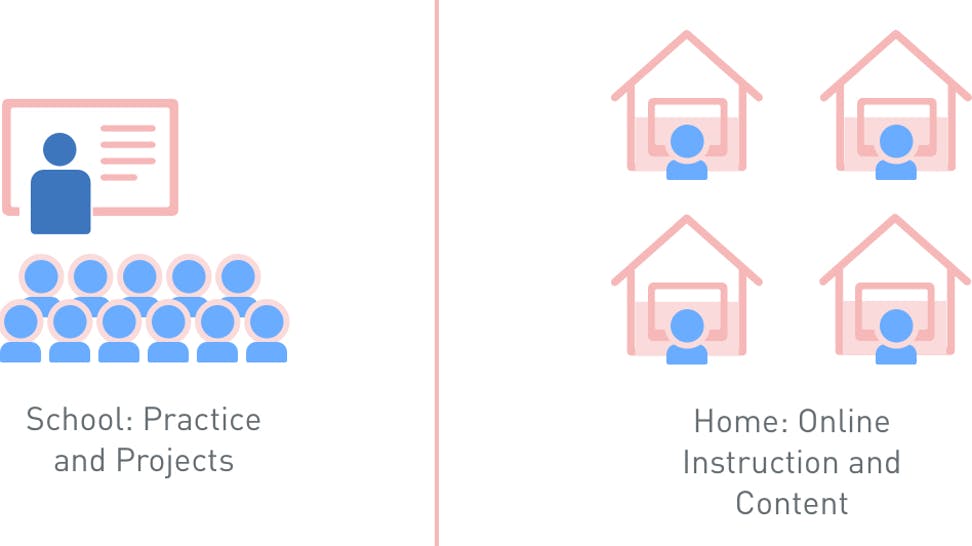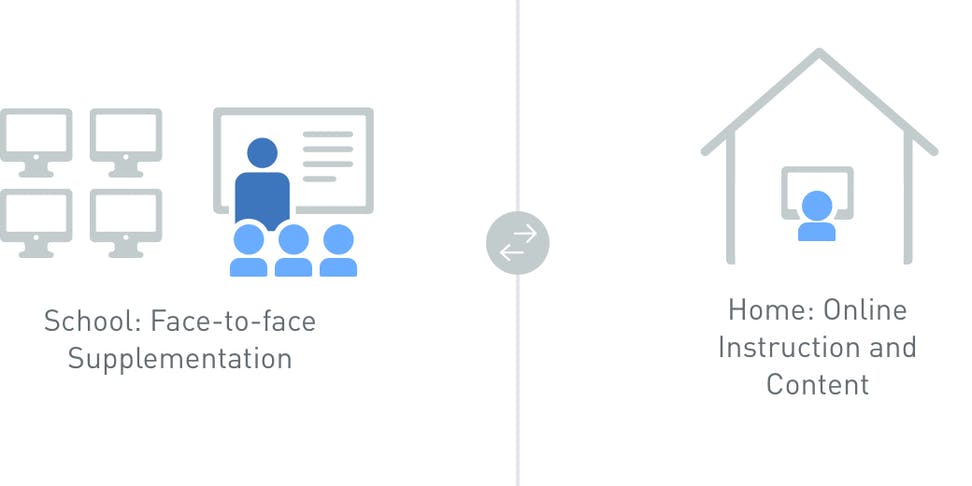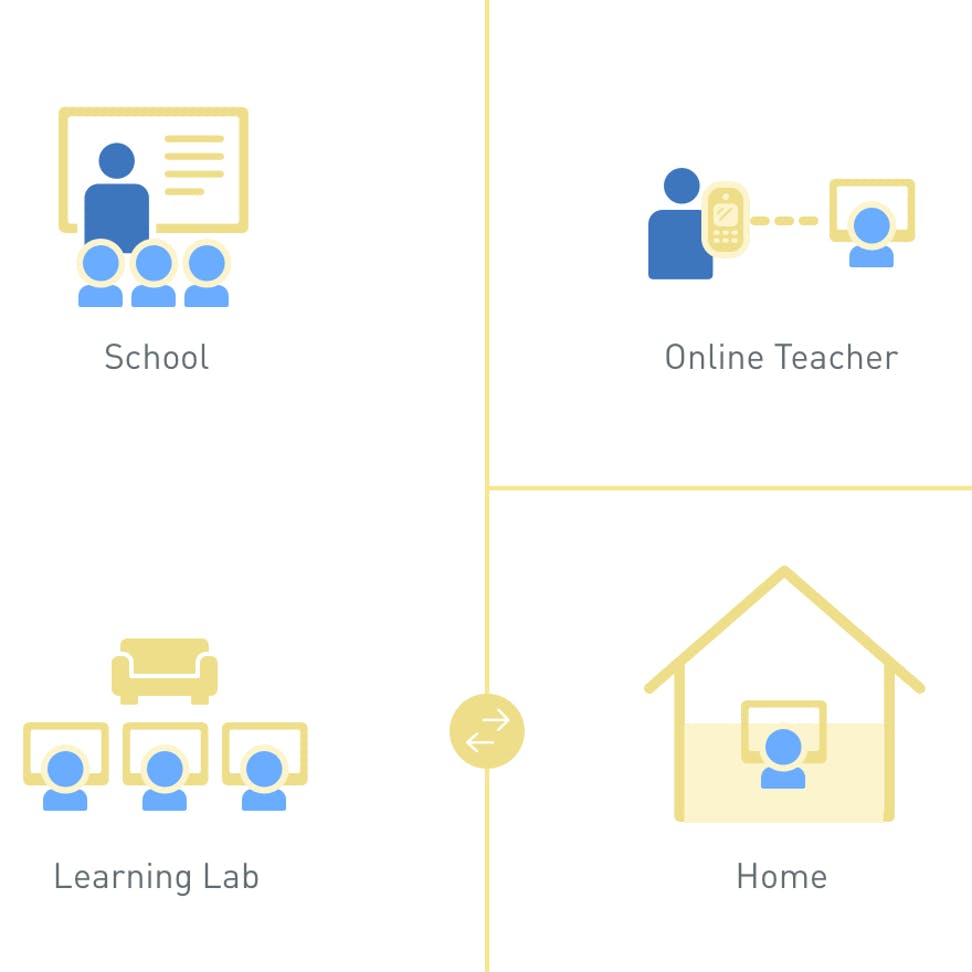Some school buildings may be open again, but things won’t be back to normal. In all likelihood, students will have to come to campuses part-time in shifts, which creates a whole host of challenges for schools as they strive to offer comprehensive educational opportunities.
Designing a new choreography for schooling may seem like a huge undertaking, but it’s not a new one. For the better part of a decade, many schools have been implementing blended learning models that integrate online learning with brick-and-mortar instruction to rethink time, space, and staffing.
Blended learning comes in a number of varieties, but across the various models, blended learning prompts educators to consider the following questions:
- What can students learn well independently, especially when aided by digital learning technologies?
- Which learning activities are most important to do together?
As schools think through their logistical challenges, consider how three blended learning models described below can help you answer the questions above, based on your priorities, needs, and available resources. The scheduling scenarios that schools are having to work through ought not to be mere logistical planning exercises to limit headcount. Instead, consider how blended learning can help reimagine resources and scheduling to maximize learning during both online and face-to-face time.
Flipped Classroom: Making the most of independent and in-class learning

The Flipped Classroom is a blended learning model that flips the traditional relationship between class time and homework. Students learn at home via online coursework or pre-recorded video lessons, and class time is focused on teacher-guided practice or projects.
The Flipped Classroom model isn’t a perfect answer to COVID-19 because it typically assumes students come to school for a full day of instruction every day. Nonetheless, the core principles of the model are immensely relevant for both part-time and full-time distance learning during the pandemic. It essentially asks: What activities are best for independent learning versus learning together? The answers can help educators maximize time spent with students, regardless if it’s in-person or virtually.
Online learning resources offer an effective way for students to learn many basic facts and skills on their own. Videos that teachers create or curate—individually or as grade-level or departmental teams—can provide effective coverage of basic content. As an added benefit, students can speed up, slow down, and replay videos as needed. Quizzes and adaptive learning software give students opportunities to review content and practice basic skills with immediate feedback. In short, when it comes to foundational learning at the bottom of Bloom’s Taxonomy or the lower levels of Webb’s Depth of Knowledge framework, students can review a lot of the materials on their own—provided they have access to good online resources.
Educators typically reserve face-to-face time for activities that deepen students’ understanding, strengthen relationships, and make learning meaningful. Top priority activities include things like class discussions, group collaboration on projects, feedback on higher-order thinking, and targeted instruction to address misconceptions.
Enriched Virtual: Optimizing for when students only come to school part-time

The Enriched Virtual model takes the elements of the Flipped Classroom one step further by making online learning the backbone of instruction. In this model, students do most of their learning independently with materials designed for fully online courses, and meet periodically with teachers at a brick-and-mortar site.
Programs that follow this model place high priority on making sure all communications and course materials are easy for students to access and navigate with minimal teacher direction or facilitation. It’s a model that could fit well with what some districts are planning for the new school year, with students coming to school only a few days out of the week.
As with the Flipped Classroom model, Enriched Virtual also encourages educators to prioritize how they use limited face-to-face instructional time. Rather than spending that time covering content, teachers often focus the few hours they have with students on addressing the particular challenges that hinder students’ independent learning—be those due to misconceptions about content, counterproductive learning habits, social-emotional difficulties, or other learning challenges.
With students slipping through the cracks during the COVID-19 pandemic, a model that allows teachers to spend in-person hours focused on identifying and addressing students’ barriers to learning seems valuable now more than ever.
A La Carte: Prioritizing in-class time for key courses and subjects

What is the A La Carte model? It’s a version of blended learning in which students who attend brick-and-mortar schools also take one or more courses online. Under normal circumstances, students usually enroll in A La Carte courses when they need additional flexibility in their schedules or when they are interested in courses—such as Arabic, sound production, or AP Psychology—that may not be offered at their local schools.
During the COVID-19 pandemic, schools might consider offering A La Carte courses to address limited building capacity. Just as Flipped Classroom and Enriched Virtual models ask educators to think carefully about which learning activities are best done independently and which are best done in-person, A La Carte prompts school and district leaders to think about which subjects or courses are best delivered online and which are best done in-person.
For example, school leaders might decide to use focus on-campus time and capacity on core subjects—such as English language arts, math, science, and social studies—and then deliver all non-core subjects via a purely virtual format. Alternatively, a school might offer more on-campus courses to students who most need in-person support—such as those at risk of failing, those who don’t have good internet access at home, or those whose parents are front-line healthcare workers—and offer A La Carte online courses primarily to students whose learning needs and family circumstances are more conducive to online learning.
We don’t yet know how much time students and teachers will be able to spend together throughout the academic year ahead. But come what may, the blended learning principles and practices highlighted above can help educators think through how to make the most of their circumstances.
This piece was originally published here on EdSurge.



